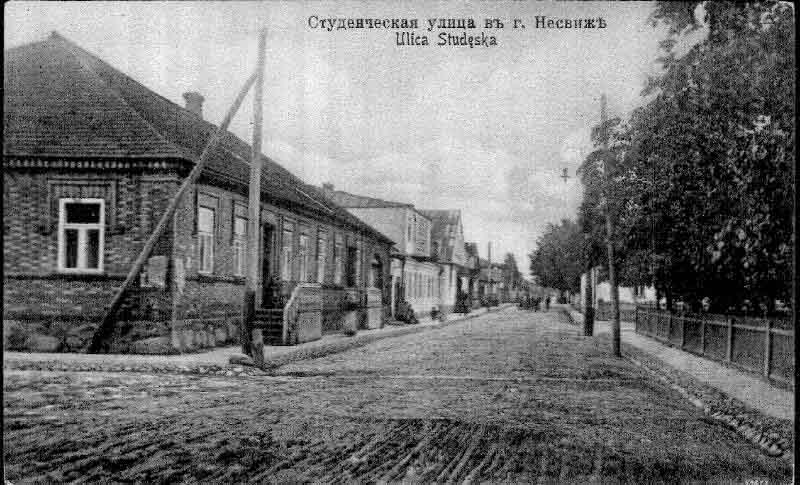

Nesvizh Study Group
 |
|
Morris R. Cohen lived several years of his life in Nesvizh. Several of the chapters in his autobiography, A Dreamer's Journey (The Beacon Press [Boston] and The Free Press [Glencoe, IL], 1949) give wonderful pictures of life in that shtetl in 1887-1890 and subsequently. Cohen later became a professor of philosophy at the City College of New York.
Below, as compiled by Judy Kunofsky, is (1) a list all the names mentioned as associated with Nesvizh and (2) some excerpts from the book that provide some of the flavor of Cohen's description of Nesvizh.
Cohen's relatives, some of whom were born in or lived in Nesvizh:
Hirsh Farfel (MRC's grandfather), p. 9 Bessie Farfel (author's mother), many references Abraham Cohen (author's father), many references Elias Farfel (uncle), 11 Sam Farfel (brother), 8, 12 Abraham Farfel (uncle), 19 Tom Cohen (brother), 23 Isaac Cohen (brother; died in infancy), 38-39 Two of the author's uncles (unspecified) changed their last names in the U.S. to Aronson and Jackson. (p. 68)
Other Jews in Nesvizh 1887-1890:
Reb Lippe, p. 27 Reb Heshiel, p. 27 Reb Nehemiah, p. 31, 37, 38 Dr. Nissem Tourov, 31 Reb Joseph Ber, 34, 56 (two first names, I believe) Zivieh (woman; niece of author's grandfather), 35 Abraham (man; nephew of author's grandfather), 36 Mr. Talpay, 42 Dr. Perlman, 68
Excerpts:
"Anyone accustomed to the American standard of living who might have come to Neshwies in those days (note: in chapter on 1887-1890) and walked through its unpaved and unlighted streets, looked into its small, unventilated and often overcrowded wooden houses, devoid of all plumbing or the simplest precautions against contagious diseases of an epidemic character, would have pronounced the town unbelievable poor, dirty, criminally ignorant as to hygiene and altogether lifeless. Indeed, he would have wondered how its six to eight thousand inhabitants managed to live at all. But while outwardly correct, he would thus have reckoned without its inner life and religius devotion which ennobled its joys and sorrows and provided strength and dignity for meeting the tasks and perplexities of the day.
"At any rate, people did manage to keep alive, to raise large families, to give their children a pious education, to build and rebuild their wooden houses and synagogues, and to send out into the world renowned writers, scholars and other distinguished men. Nor did Neshwies forget that it had been the home of Solomon Maimon, the greatest Jewish philosopher since Spinoza, of Reb Isaac Elkhanon, one of the great rabbis of the nineteenth century, and of Shomer (M.M. Shaikewich), the Dumas of modern Yiddish literature."
"About the dirt and material poverty of the town there could be no doubt. It was miles from the nearest railway station. There were no factories or large industries to sustain its economy. So far as any one could tell, the town lived on trade with the peasants who brought to its markets their wood, potatoes and grain and took back salt, nails, kerosene, and sometimes linen goods, shoes and other 'luxuries,' besides a little money to help pay their taxes. The stationing of a cavalry regiment must have added to the commerce of the town, though the military supplies came in wagons from the outside world, and the officers and soldiers did not seem to have very much money to spend." (pp. 25-26) ...
"As the majority of the "Goyim" (Gentiles) whom one met in Neshwies were peasants or poor city dwellers, some of them former serfs, few of them literate, the Jews generally regarded them as an inferior race.... In later years I had occasion to note the paradox that the Russian Jews, who were then poor and horribly persecuted, confidently regarded themselves as the superiors, while the more affluent and better educated German and other Jews regarded their Gentile fellow citizens as the superiors to be imitated." (p. 28) ...
"As I reflect on it now, life in Neshwies illustrates the familiar hedonistic paradox that people attain happiness more readily when they do not strain to attain it. In the mind of my grandfather, and of the pious people whom I met, the accepted view was that life on this earth is an expiation, a corridor to the life beyond, and the only worthwhile activity in this corridor is to acquire merit for what is to come. Nothing, therefore, was considered of real importance, except as it bore on religion, the prescriptions of which were generally known. Only occasionally did we have to go to the "Dayin" (judge) to settle a point of ritual. Hence followed the great paradox that this life, despite its lack of material resources and outer graciousness, still harbored not only a sustaining peacefulness but also a sense of superiority to those who cared for worldly goods. Renunciation led to fulfillment." (pp. 39-40) ...
"For all its poverty and lack of modernity Neshwies was a noble nursery of men and women" (p. 69) ...
"The people of Neshwies, in the days of my childhood, wore rags on their feet and ate white bread only on the Sabbath, but no child went without schooling." (p. 224) (This quote is in at least one book of Jewish quotations.)
Compiled by the members of the Nesvizh
Study Group
Facilitator and Webmaster:Steve
Stein
Copyright © 1997-2017
Created by Mike Meshenberg in 1997
and maintained by Mike Meshenberg until
March 2016
Updated 11/24/2017
Webmaster Emeritus: Brad Lakritz